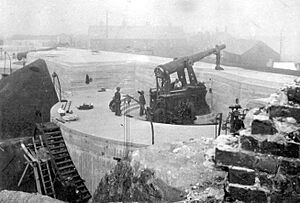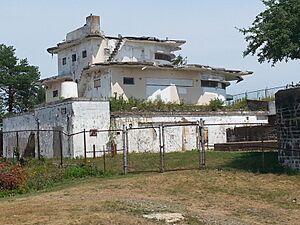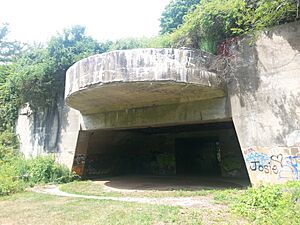Harbor Defenses of Portsmouth facts for kids
Quick facts for kids Harbor Defenses of Portsmouth |
|
|---|---|
| Active | 1900-1950 |
| Country | |
| Branch | United States Army Coast Artillery Corps |
| Type | Coast artillery |
| Role | Harbor Defense Command |
| Part of |
|
| Garrison/HQ |
|
| Motto(s) | We are one |
| Mascot(s) | Oozlefinch |
The Harbor Defenses of Portsmouth was a special military command. It was part of the United States Army Coast Artillery Corps. Its job was to protect the coast around Portsmouth, New Hampshire. This included the important Portsmouth Naval Shipyard in Kittery, Maine.
These defenses were active from 1900 to 1950. They used large cannons and underwater minefields. The command started around 1900 as the Portsmouth Artillery District. It was later renamed "Coast Defenses of Portsmouth" in 1913. In 1925, it became the "Harbor Defenses of Portsmouth."
Contents
Protecting the Coast: A Look at Portsmouth's Forts
Early Forts and the American Revolution
The first fort in the Portsmouth area was Fort William and Mary. It was in New Castle. This fort might be the oldest continuously used fort in the British colonies. It was first used even before 1632.
In 1680, another small fort was built. This was on the site of what became Fort McClary in Kittery, Maine. It was first called Fort Pepperrell. By 1720, it had six cannons and was named Fort William.
Both Fort William and Mary and Fort William were important during the American Revolution. On December 14-15, 1774, Fort William and Mary was raided. American patriots led by John Langdon took gunpowder. The next night, another group led by John Sullivan took 16 cannons. These raids were the first acts of the Revolution in New Hampshire.
Other forts built during the Revolution were Fort Washington and Fort Sullivan. Fort Washington was on Peirce Island in Portsmouth. Fort Sullivan was on Seavey's Island in Kittery. Both were built in 1775. They were used again in the War of 1812, then closed.
After the Revolution, Fort William and Mary was rebuilt. In 1808, it was renamed Fort Constitution. Fort McClary was built across the river around the same time. During the War of 1812, a Martello tower (a round defensive tower) was added to Fort Constitution.
During the Civil War, both forts were expanded. However, these projects were stopped in 1867. This was because new cannons could easily destroy old stone forts.
Modernizing Defenses: The Endicott Period
In 1885, a group called the Endicott Board suggested new forts. Construction began in 1898 to defend Portsmouth. Three main forts were built: Fort Stark, Fort Foster, and new batteries near Fort Constitution. An underwater minefield also protected the harbor.
When the Spanish–American War started in 1898, defenses were rushed. Temporary batteries were quickly set up. Fort Stark got two 8-inch guns. Fort McClary received three 15-inch guns. These temporary guns were later removed as the new, modern forts were completed.
The new forts were finished by 1905. Fort Stark had two 12-inch guns and two 6-inch guns. These guns were on "disappearing carriages." This meant they would pop up to fire, then lower back down to hide. Fort Foster had three 10-inch disappearing guns. Fort Constitution had two 8-inch disappearing guns. All forts also had smaller 3-inch guns to protect the minefields.
World War I and Changes
When America joined World War I, the Coast Artillery changed a lot. They were the only part of the Army with experience using large cannons. So, they were chosen to operate most of the heavy guns in the war.
Many guns were removed from the forts. They were sent to Europe to help in the war. For example, the 10-inch guns from Fort Foster and the 8-inch guns from Fort Constitution were taken away. After the war, some guns were returned, but others were not.
Many temporary buildings were built at the forts. This was to house all the new soldiers. A new camp, Camp Langdon, was also set up in New Castle. This was because the forts didn't have enough space.
Between the Wars
In 1920, a new building for controlling mines was built at Fort Constitution. In 1925, the "Coast Defenses" commands were renamed "Harbor Defenses." The Harbor Defenses of Portsmouth (HD Portsmouth) was mostly in "caretaker status" during this time. This means it was not very active.
Camp Langdon got two anti-aircraft guns in 1920. These guns were removed in the early 1930s.
World War II and New Defenses
During World War II, many temporary buildings were built again. Camp Langdon became the main headquarters for HD Portsmouth. After France fell to Germany in 1940, the Army decided to build new, very powerful 16-inch guns.
Fort Dearborn was built in Rye. It had Battery Seaman, with two huge 16-inch guns. This battery replaced all the older, heavy guns in the area. These old guns were scrapped by 1945.
Two Anti-Motor Torpedo Boat (AMTB) batteries were also built. One was near Fort Dearborn, and another at Fort Foster. Each had four 90 mm guns and two 40 mm Bofors guns. These guns could shoot at both ships and airplanes.
A new building to control the harbor entrance was built at Fort Stark. It was designed to look like a fancy beach house. This was to hide it from enemies.
The US Navy also helped protect Portsmouth. They used nets and special sensors to find enemy submarines.
After World War II
After World War II, it became clear that gun defenses were no longer needed. They were too old-fashioned. All the guns were removed by the end of 1948. In 1950, the Coast Artillery Corps and all Army harbor defense commands were closed down.
Portsmouth's Forts Today
The forts around Portsmouth are very well-preserved. Many are open to the public. They show how forts were built from 1808 to 1945.
Most forts are in public parks. Fort Constitution is on a Coast Guard station but is also open. You can see its old walls and the lighthouse.
Fort McClary has a well-preserved blockhouse. You can also see parts of its unfinished Civil War expansions. The site of Fort Washington is now a water treatment plant, but some old earthworks remain.
Fort Stark has a small museum. It also has the unusual hidden harbor entrance post. Fort Dearborn is now Odiorne Point State Park. You can walk to see the huge 16-inch gun battery.
Fort Foster Park has a public beach. It also has a rare World War II mine control building. Several other old control towers are still along the New Hampshire coast.
Camp Langdon is now Great Island Common, a park. Only the spots where three anti-aircraft guns used to be remain.
Coat of Arms
The Harbor Defenses of Portsmouth had its own special symbol, called a coat of arms.
- Shield: It has eight triangles, half blue and half red. This comes from an old New Hampshire flag from the Revolutionary War. It reminds us of the capture of Fort William and Mary in 1774. This was one of the first American victories in the Revolution. The shield also shows a fort with three points. These points represent the three main forts: Fort Constitution, Fort Foster, and Fort Stark. They are joined together to show how they worked as one team.
- Motto: "We are one." This motto also comes from the old flag. It means the forts worked together to protect Portsmouth.
- Crest: This part shows a ship being built. It comes from the seal of New Hampshire. It shows that Portsmouth is the only port in the state. The ship is red, which is the color of the Coast Artillery Corps.







